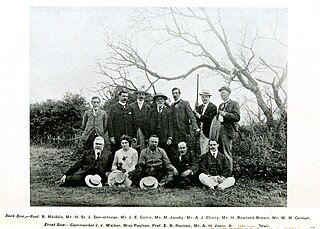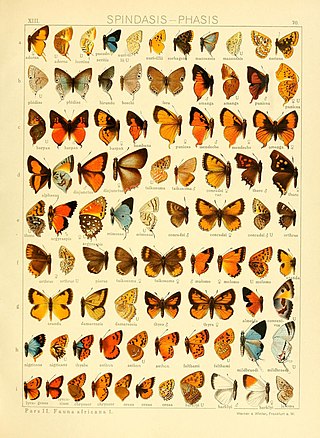
The superfamily Papilionoidea contains all the butterflies except for the moth-like Hedyloidea.

Lycaenidae is the second-largest family of butterflies, with over 6,000 species worldwide, whose members are also called gossamer-winged butterflies. They constitute about 30% of the known butterfly species.

Riodinidae is the family of metalmark butterflies. The common name "metalmarks" refers to the small, metallic-looking spots commonly found on their wings. The 1,532 species are placed in 146 genera. Although mostly Neotropical in distribution, the family is also represented both in the Nearctic, Palearctic, Australasian (Dicallaneura), Afrotropic, and Indomalayan realms.

The short-tailed blue or tailed Cupid is a butterfly that forms part of the family Lycaenidae. It is found from Europe to Japan and in India.

Lycaeninae, the coppers, are a subfamily of the gossamer-winged butterflies (Lycaenidae).

Miletinae is a subfamily of the family Lycaenidae of butterflies, commonly called harvesters and woolly legs, and virtually unique among butterflies in having predatory larvae. Miletinae are entirely aphytophagous. The ecology of the Miletinae is little understood, but adults and larvae live in association with ants, and most known species feed on Hemiptera, though some, like Liphyra, feed on the ants themselves. The butterflies, ants, and hemipterans, in some cases, seem to have complex symbiotic relationships benefiting all.

Polyommatinae, the blues, are a diverse subfamily of gossamer-winged butterflies.

The Aphnaeinae are a subfamily of butterflies in the family Lycaenidae.

George Thomas Bethune-Baker was an English entomologist who specialised in Lepidoptera, especially those in the family Lycaenidae of butterflies.

Zizeeria knysna, the dark grass blue or African grass blue, is a species of blue butterfly (Lycaenidae) found in Africa, on Cyprus and the Iberian Peninsula.

Zeritis is a genus of butterflies in the family Lycaenidae. The species of this genus are found in the Afrotropical realm.

Rachana is a genus of butterflies in the family Lycaenidae.

Chrysoritis felthami, the Feltham's opal, is a butterfly of the family Lycaenidae. It is found in South Africa. It was originally described by Roland Trimen under the name Zeritis felthami. This species was named in honour of Henry Louis Langley Feltham.

Hamilton Herbert Charles James Druce was an English entomologist who specialised in Lycaenidae and to a lesser extent Hesperiidae. He is not to be confused with his father, the English entomologist Herbert Druce (1846–1913) who also worked on Lepidoptera.

Zeritis aurivillii is a butterfly in the family Lycaenidae. It is found in Cameroon.
Zeritis fontainei is a butterfly in the family Lycaenidae. It is found in the Democratic Republic of the Congo and Zambia.

Zeritis neriene, the checkered gem, is a butterfly in the family Lycaenidae. It is found in Senegal, The Gambia, Guinea, Burkina Faso, Sierra Leone, Ivory Coast, Ghana, Benin, Nigeria, southern Niger, Cameroon, the Central African Republic, southern Sudan, Uganda, and western Kenya. The habitat consists of savanna, where it is found on sandy soils and open stony ground with short grass.

Zeritis pulcherrima is a butterfly in the family Lycaenidae. It is found in Sudan and the Central African Republic.

Zeritis sorhagenii, the scarce gem, is a butterfly in the family Lycaenidae. It is found in Angola, the Democratic Republic of the Congo, Zambia, Zimbabwe and Botswana. The habitat consists of understorey grass in open Brachystegia woodland.
















